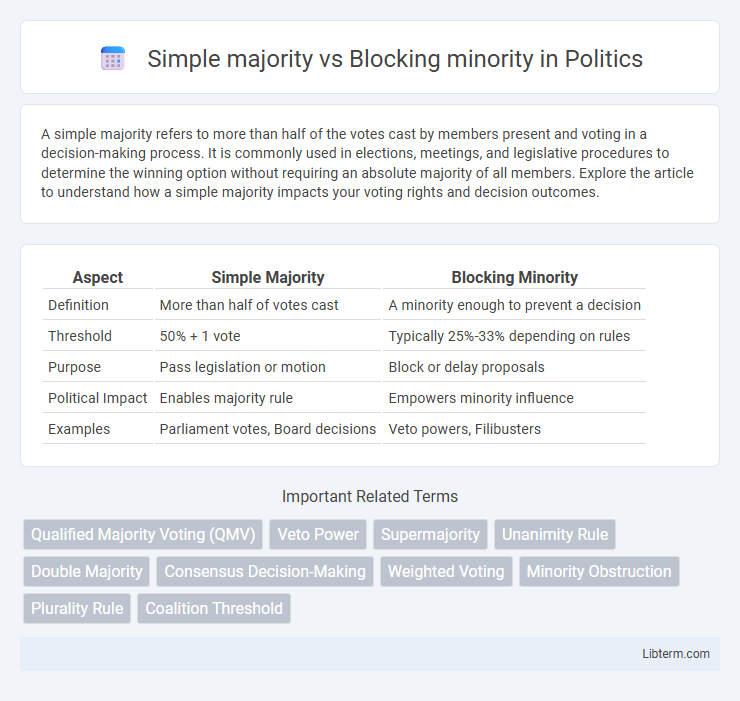A simple majority refers to more than half of the votes cast by members present and voting in a decision-making process. It is commonly used in elections, meetings, and legislative procedures to determine the winning option without requiring an absolute majority of all members. Explore the article to understand how a simple majority impacts your voting rights and decision outcomes.
Table of Comparison
| Aspect | Simple Majority | Blocking Minority |
|---|---|---|
| Definition | More than half of votes cast | A minority enough to prevent a decision |
| Threshold | 50% + 1 vote | Typically 25%-33% depending on rules |
| Purpose | Pass legislation or motion | Block or delay proposals |
| Political Impact | Enables majority rule | Empowers minority influence |
| Examples | Parliament votes, Board decisions | Veto powers, Filibusters |
Introduction to Simple Majority and Blocking Minority
A simple majority refers to obtaining more than half of the votes cast, enabling decisions to be made efficiently in legislative or organizational contexts. Blocking minority occurs when a sufficiently large minority group prevents the adoption of a proposal, often requiring a specific threshold below the majority to halt progress. These mechanisms balance decision-making power, ensuring majorities can enact policies while protecting minority interests from being overridden.
Defining Simple Majority
A simple majority refers to more than half of the votes cast in a decision-making process, typically over 50%, enabling a proposal or motion to pass. It contrasts with a blocking minority, which is a sufficient number of votes to prevent a decision despite lacking majority support, often requiring a defined threshold such as 25% or one-third. Understanding the simple majority is crucial for organizations and legislative bodies to determine clear and efficient outcomes in voting scenarios.
Understanding Blocking Minority
Blocking minority represents the smallest number of votes required to prevent a decision from being adopted, typically in legislative or organizational voting systems. This concept plays a crucial role in protecting minority interests by ensuring that a substantial minority can halt proposals, thus requiring broader consensus for approval. Understanding the threshold and strategic use of blocking minority helps in navigating political negotiations and decision-making processes effectively.
Historical Context and Origins
The concept of a simple majority dates back to ancient democratic practices, notably in Greek city-states where decisions were made by more than half of the members present. The blocking minority emerged as a safeguard in legislative or corporate settings to prevent decisions from being made without substantial consensus, reflecting concerns over the tyranny of the majority. Historically, these mechanisms evolved to balance efficient decision-making with protection of minority interests, shaping modern voting systems and governance structures.
Key Differences Between Simple Majority and Blocking Minority
A simple majority requires more than half of the votes to pass a decision, ensuring that the greater share of participants supports the proposal. A blocking minority, by contrast, is a smaller group that holds enough votes to prevent a decision from being approved, despite not holding a majority. The key difference lies in their function: a simple majority enables action, while a blocking minority protects against unwanted decisions by requiring consensus or supermajority thresholds.
Applications in Decision-Making Processes
Simple majority enables faster decision-making by requiring more than half of votes to approve proposals, commonly applied in legislative bodies and corporate boards. Blocking minority grants a smaller group the power to prevent a decision, ensuring protection of minority interests in international organizations or shareholder meetings. These mechanisms balance efficiency and inclusiveness, influencing governance structures and policy outcomes.
Impact on Voting Outcomes
Simple majority voting allows decisions to be approved when more than half of the votes are in favor, often leading to faster decision-making and clearer outcomes. Blocking minority mechanisms empower a minority group, typically representing a defined threshold below 50%, to prevent decisions, ensuring greater protection of minority interests and encouraging broader consensus. The impact on voting outcomes includes a balance between efficiency and inclusiveness, where simple majority favors decisive action, while blocking minority promotes negotiation and safeguards against potential domination by the majority.
Examples in Political Systems
A simple majority occurs when more than half of the votes support a decision, as seen in the U.S. House of Representatives where legislation passes with 218 out of 435 votes. Blocking minority is exemplified in the European Union Council, where a coalition representing at least 35% of member states can veto proposals, ensuring that a substantial minority can prevent majority decisions. These mechanisms balance majority rule with minority protection in political systems worldwide.
Advantages and Disadvantages
Simple majority voting enables faster decision-making by requiring over 50% approval, promoting efficiency and clear outcomes. However, it risks marginalizing minority interests and can lead to decisions that overlook significant dissent. Blocking minority mechanisms protect smaller groups by allowing them to prevent decisions, ensuring balanced representation, but they may also cause stalemates and slow down governance processes.
Conclusion and Future Implications
The concept of simple majority streamlines decision-making by requiring more than half the votes, promoting efficiency and clarity in governance processes. Blocking minority safeguards minority interests by empowering a substantial minority to prevent decisions, fostering inclusivity but potentially slowing consensus. Balancing these mechanisms is critical for future institutional frameworks to ensure both effective governance and protection of diverse stakeholder rights.
Simple majority Infographic

 libterm.com
libterm.com